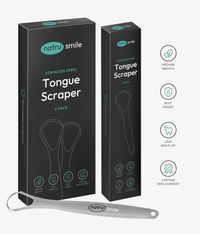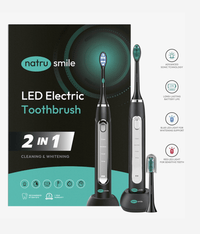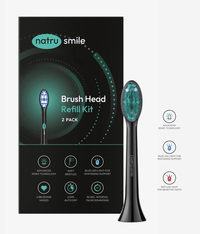
All products are certified by dental expert Dr. Greg Grillo
According to the American College of Prosthodontists, around 120 million people in the U.S. are missing at least one tooth. And this figure is expected to grow due to diets high in sugar, poor oral hygiene habits, and an aging population. If you’re one of those 120 million, a cantilever dental bridge may be right for you.
If you’re thinking of getting a dental bridge to replace your missing tooth, what about a cantilever dental bridge? Compared to a traditional bridge that requires support from adjacent teeth, a cantilever bridge only needs one tooth for support.
This type of bridge has a range of benefits and downsides that can help determine whether it’s right for your mouth. Let’s take a look at what this kind of bridge has to offer and how it could be a good fit for your dental needs!
What Is A Cantilever Dental Bridge? (Overview)
A cantilever dental bridge in dentistry is a type of bridge that is used to replace missing teeth. As the name suggests, it’s only supported on one end, while the other end is unsupported and free-floating. This means that there’s no need for adjacent teeth to provide support for the bridge like in a traditional or conventional bridge.
Cantilever bridges are one of the two main types of fixed dental prosthetics, alongside traditional dental bridges. There isn’t truly such a thing as removable dental bridges, so if you're looking for that option, you'll need to consider dentures.
How Does A Cantilever Dental Bridge Work?
Dental bridges are prosthetic teeth that fill the gap created by a missing tooth or multiple missing teeth. Bridges can be supported by two adjacent natural teeth, implants, or other dental structures. Dental crowns and tooth bridges have a strong relationship. When a bridge is used, the adjacent teeth will need to be prepared for dental crowns in order to provide support for the bridge.
A cantilever dental bridge works by having one crown attached to an artificial tooth, or pontic. This creates an “arm” that extends from the pontic towards the supporting tooth. With a traditional dental bridge, two crowns are placed on the teeth adjacent to the pontic.
People opt for a cantilever bridge when there aren’t adjacent teeth available to support the bridge. It can also be used if the remaining tooth is too weak to support an implant. They ultimately work by providing the same support as a traditional bridge but with fewer teeth involved.
When Is A Cantilever Bridge Used On Teeth?
A cantilever bridge is typically used when there are only a few teeth missing in a row. It’s most commonly used when the gap between two teeth is too large to be filled with just one pontic, as would be done with a traditional bridge. This type of bridge may also be recommended if the adjacent teeth are not strong enough to support a conventional bridge or if there is an issue with decay or infection on those teeth.
Other potential scenarios include:
- When only one tooth is missing and there are no adjacent teeth available to provide support
- When the patient cannot have a dental implant due to bone loss or other issues
- When the patient doesn’t want to commit to a longer-term solution, such as an implant
Benefits Of A Cantilever Dental Bridge
Cantilever bridges offer a number of benefits to patients who need to replace missing teeth. We’ve outlined a few of the key advantages:
Easy To Place
A cantilever dental bridge is much easier to place than a traditional bridge because it requires less preparation work. This means the patient can have their new smile in place faster and with fewer visits to the dentist!
While typical bridges require the adjacent teeth to be shaved down and fitted with crowns, a cantilever bridge only requires one tooth to be prepared. This can also help reduce discomfort and save time in the dental chair.
Low-Cost
Cantilever bridges are usually much less expensive than other types of dental bridges because they take less work and fewer parts. This makes them an ideal option for those who need to replace missing teeth but may not have the budget for more expensive solutions such as implants or traditional bridges.
On average, a cantilever bridge costs $2,000 to $5,000, while an implant-supported bridge costs $4,000 to $16,000.
Natural Appearance
There’s also the advantage of cantilever bridges being very natural-looking. They are designed to blend in seamlessly with your existing teeth and give you a beautiful, confident smile for years to come. They can be made with porcelain, ceramic, or a combination of materials to create a smile that looks just like your own.
Maryland dental bridges, on the other hand, have metal wings that can be visible in some circumstances, which may not be as attractive.
Less Invasive
Getting a dental bridge can be a tough experience for some people. Cantilever bridges are much less invasive than traditional bridges, as they require only one tooth to be prepared, and no adjacent teeth need to be shaved down for support. As only one other tooth will be impacted, there’s less of a disturbance to natural tooth surfaces.
All this makes them a great option for those who don’t want to go through the hassle of undergoing a major dental procedure.
Fewer Complications
One of the main advantages of a cantilever bridge is that there are fewer complications and risks involved with this type of bridge because only one abutment is used.
This reduces the amount of work that needs to be done to prepare adjacent teeth for their new role as abutments, which can lead to less trauma and discomfort for patients. They are less likely to cause gum disease or decay in the adjacent teeth since they don’t require any modifications to these teeth.
In addition, since only one tooth needs to be prepared in this way, it also tends to reduce overall treatment time compared with traditional bridges.
More Conservative Option
Cantilever bridges offer a more conservative option than traditional bridges, which often require shaving down two or more teeth to provide the necessary support. With cantilever bridges, only one tooth needs to be prepared for placement, making it less invasive and allowing surrounding teeth to remain intact.
This bridge type is also reversible, meaning it can be removed without damaging the existing teeth.
Longevity
Cantilever bridges can last up to 15 years or longer with proper care. As with any dental restoration, regular brushing and flossing are necessary to maintain the bridge’s integrity and make sure it doesn’t become loose over time.
A study in the Journal of the American Dental Association found that cantilevered prostheses had a five-year survival rate of 94.3%.
What Are The Downsides Of Cantilever Dental Bridge
Cantilever bridges can be a great solution for some people; however, it’s important to remember that this type of bridge does have some drawbacks.
Limitations
One of the main limitations is that cantilever bridges are best for replacing one missing tooth in an area where there aren’t any adjacent teeth. If there are other teeth in the vicinity, it’s best to use traditional bridges because they provide more support.
Cantilever bridges can also be prone to failure if the single tooth isn’t strong enough to support the bridge. If this is the case, a traditional bridge may be a better option. They are really only recommended for teeth that don’t take functional load, such as upper and lower anterior teeth.
Durability
Due to the single-tooth support, cantilever bridges can be more prone to damage than traditional bridges. If too much pressure is placed on the bridge, it can lead to further tooth damage or even fracture of the bridge itself.
As a result, it’s important to be mindful of how much pressure is put on the bridge when biting and chewing. This type of bridge may also need to be replaced more often than other types of dental bridges as it can wear down faster due to its design.
Possibility Of Failure
Due to their design and the fact that they are only supported by one tooth, cantilever bridges can be more prone to failure than traditional bridges. This means that if it is not properly cared for or if there is a lot of stress and pressure put on the bridge, it could easily break or come loose.
Cantilever Bridge Dental Procedure
If you've settled on a cantilever bridge, the dental procedure will be similar to that of a traditional bridge. The first step is to prepare the abutment tooth (the one providing support) by shaving off some enamel and creating an impression.
The next step is for your dentist to create a custom-made crown or pontic (replacement tooth), which will need to be fitted precisely over the abutment tooth and surrounding teeth. Your dentist may decide to use porcelain for the crown or pontic, as it blends in better with your existing teeth.
Once the bridge is ready, it’s secured onto surrounding teeth using a special adhesive and further cemented into place to ensure maximum stability.
The procedure will take a few visits to complete, and you may need follow-up appointments to make sure the bridge is fitting properly. Overall, you'll be in the dentist’s chair for around 4 to 6 hours.
Cantilever Dental Bridge Cost
The cost of a cantilever bridge can vary depending on the materials used and how complex the procedure is. Generally, you can expect to pay around $2,000 - $5,000 for a single tooth replacement.
Cantilever Dental Bridge Alternatives
If your dentist deems a cantilever bridge inappropriate for your mouth, there are plenty of other alternatives.
Maryland Bridge
A Maryland bridge is otherwise known as a resin-bonded fixed partial denture - quite the mouthful! Instead of fully covering the adjacent teeth with crowns, it uses metal wings to attach the floating tooth.
Maryland bridges are cheap, minimally invasive, and don’t require invasive surgery. It’s a great way to preserve tooth structure as it doesn’t involve placing any crowns; however, there’s a possibility of it making the supporting teeth darker in color due to the bonding metal.
Traditional Bridge
Traditional bridges are the most popular type of dental bridges. It consists of two crowns on either side of a pontic (replacement) tooth, and all three are fused together to create one piece. Unlike the Cantilever and Maryland bridges, these require support from adjacent teeth in order to stay secure.
When it comes to materials, the traditional bridge has the most options - metal, porcelain fused to metal, and ceramics. This option is most suitable for molars, as they don't show up when you smile.
Dental Implant
Getting a dental implant involves a surgical procedure that replaces the root of the missing tooth with a screw-like titanium post. A crown or bridge is then placed on top of the implant, creating a natural-looking and functioning replacement tooth.
If you’re wondering whether to go for a bridge or implant, here are some things to weigh out.
While dental implants are the longest-lasting option for missing teeth on the market (lasting 15 years!) and maintain their natural look longer than bridges, dental bridges don’t require surgery or bone grafting and are more cost-effective. So compared to a dental bridge, this option is more expensive and requires a longer recovery time - but it also offers the most stability and longevity.
Partial Dentures
Partial dentures are removable, and they’re made to replace multiple teeth with fake teeth attached to a plastic base. The base is designed to fit snugly around the remaining teeth in your mouth. These can be taken out as needed, making them easy to clean and maintain. Partial dentures also cost less than other dental bridge options, at around $500 to $1,500.
For more information on cantilever dental bridges, here are some commonly asked questions.
Are Cantilever Dental Bridges Strong?
Yes, cantilever dental bridges are just as strong as traditional ones. The only difference is that they rely on one abutment tooth for support instead of two. But if you’re looking for the strongest dental bridge possible, you should opt for an implant-supported dental bridge.
How Long Does The Cantilever Dental Bridge Last?
Cantilever dental bridges last anywhere from 5 to 15 years, depending on how well they’re taken care of and the quality of the materials used. Eventually, the bridge will need to be replaced, just like any other dental restoration.
What Does A Cantilever Dental Bridge Look Like?
A cantilever dental bridge looks similar to traditional dental bridges. While a traditional one is made up of two abutment teeth and a pontic (replacement) tooth in between, a cantilever bridge is held in place by just one crown on the other side of your replacement tooth. Think of a traditional dental bridge but without one of the sides present.
Are Cantilever Dental Bridges Good?
Cantilever dental bridges can be a good option for certain people. They are less invasive than traditional bridges, as they don't require support from adjacent teeth.
Depending on the location of your missing tooth, though, a cantilever bridge may not be the best choice. Those that don't qualify include people with a missing tooth in the back of their mouth, those without enough room for the bridge, and those with weakened teeth.










